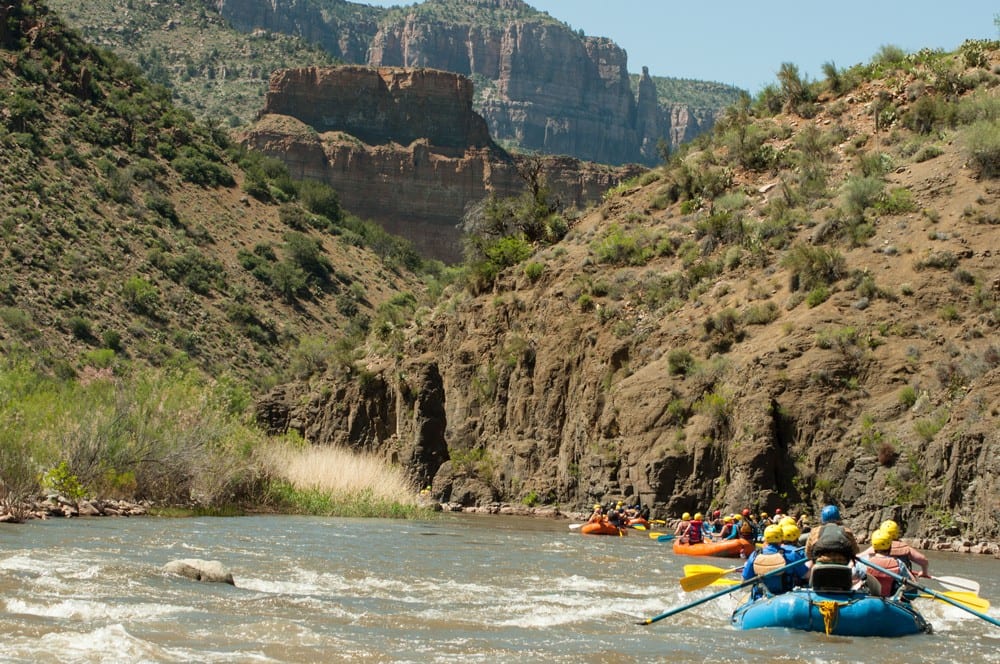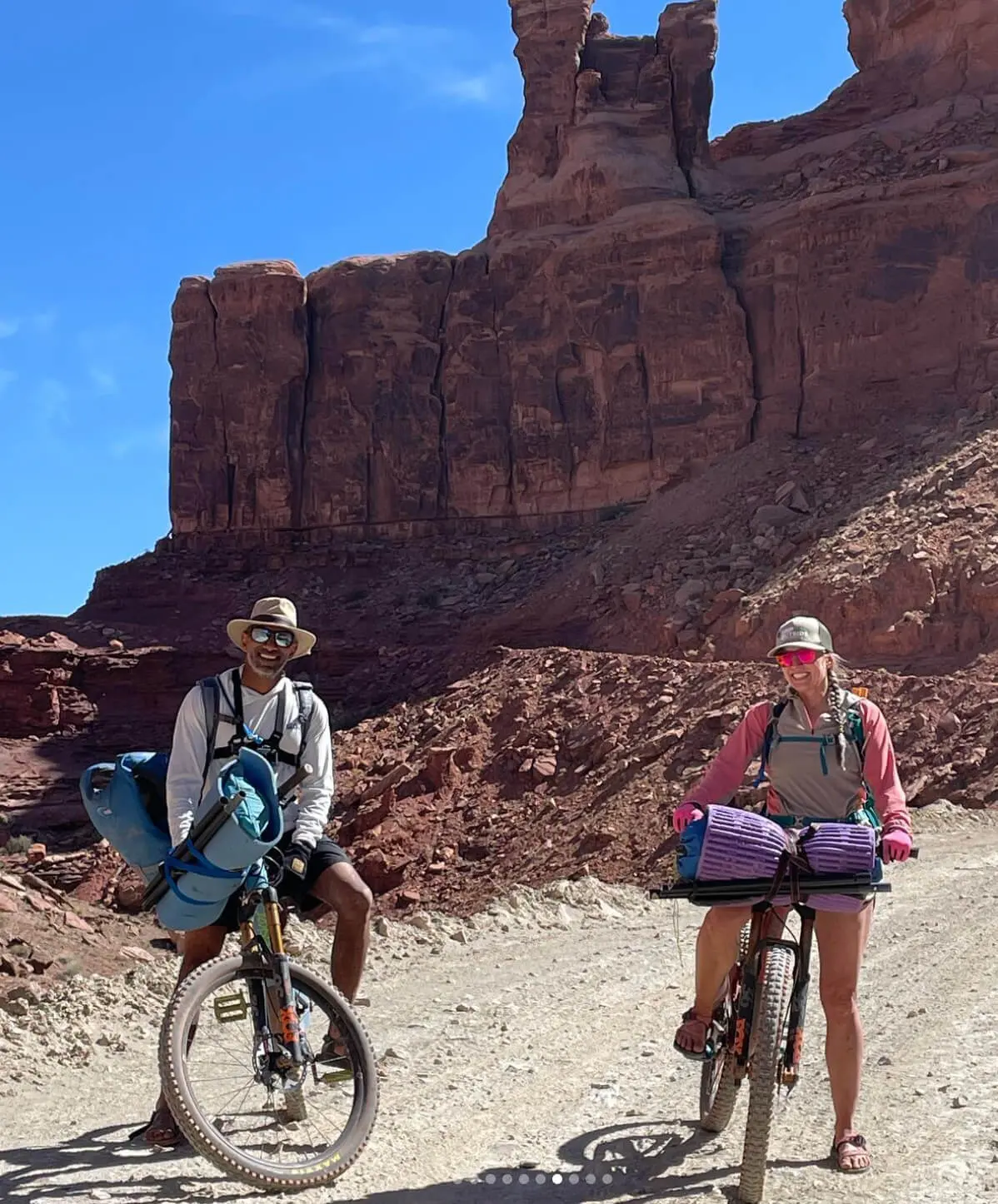Beginner White Water Rafting – From the Rafting Experts
Thinking about trying out whitewater rafting? Beginners to whitewater rafting are in for a dose of nature and adrenaline, perfect for those looking to shake up their routine with something exciting. In this guide, we tapped into the expertise of our vetted and curated whitewater rafting outfitters and guides across the country, alongside insights from our in-house rafting expert – a former whitewater rafting guide and Communications & Sales Director for a major rafting outfitter. Together, they’ve detailed everything you need to know as a beginner, from understanding rapid classifications to choosing the perfect first river trip. Join us as we explore what makes whitewater rafting a must-try adventure!
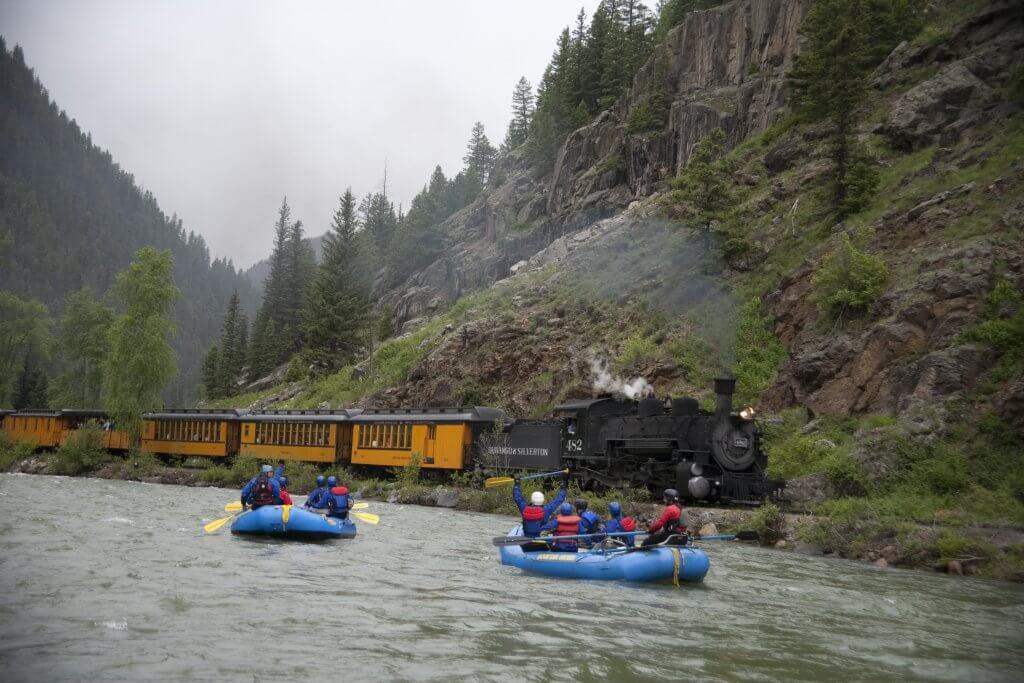
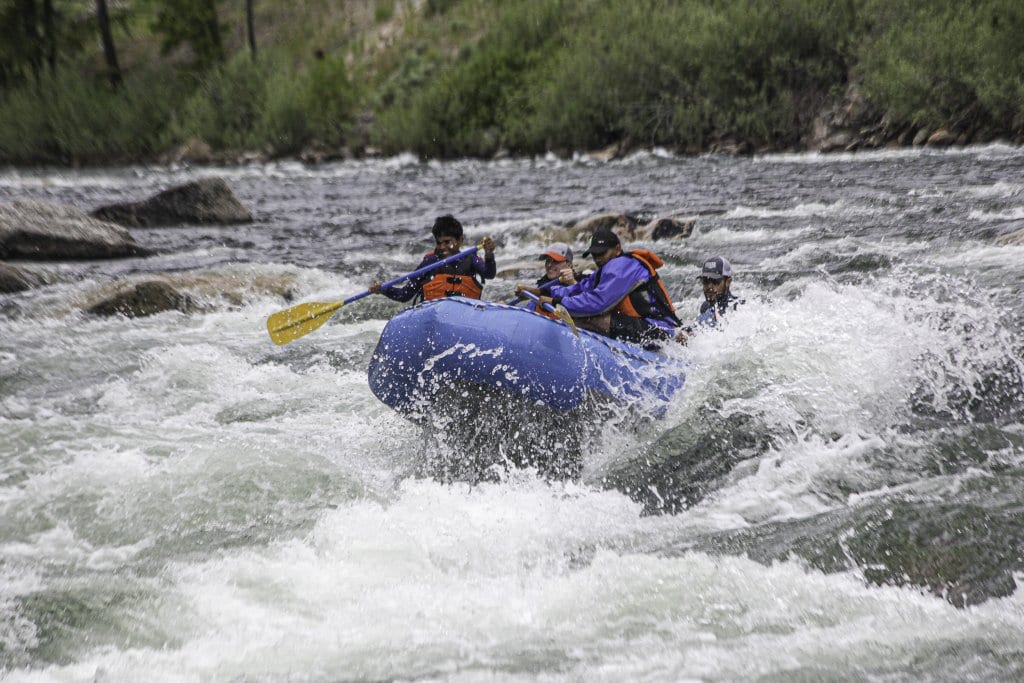
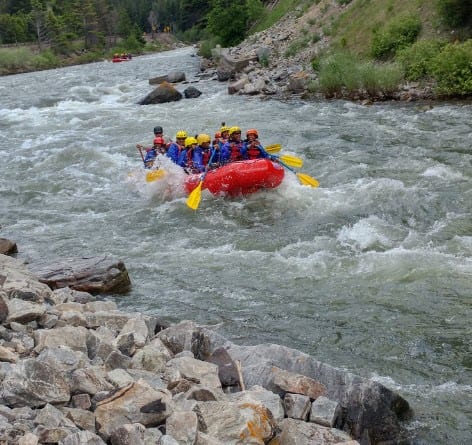
What is Whitewater Rafting?
Whitewater rafting is a popular outdoor adventure typically booked as a guided tour with a local river guide. An inflatable raft is used to navigate a river with rapids. It is called whitewater because the frothy water takes on a white appearance because of the way it flows over rocks, drops, and fast currents. Rapids are created by the river’s gradient (or how steep it is), obstructions like rocks and boulders, narrow channels that constrict a river’s flow, and the flow rate of a river.
Whitewater rafting is done on rivers with rapids, which vary in difficulty. Whitewater rapids are categorized in an internationally accepted class I-VI system, depending on the size and technicality of the rapids. This is different from a river float or tubing adventures, which typically take place on rivers with little or no whitewater. The class or level of rapids will be the best indication of the difficulty of the trip, so you can choose whether to head out on a peaceful float or take on some exciting rapids. The right gear, guide, and experience are needed for more challenging rivers.
Contrary to what you might expect, river trips are not all whitewater. On any given rafting trip, there is typically a mix of rapids as well as calmer areas of the river in between the rapids. On summer trips, many rivers are suitable for jumping in for a swim in the calmer spots, which also make for great photo opportunities. The rush of whitewater and the typically spectacular scenic views along the river make whitewater rafting an ideal spring and summer activity.
Whitewater Rafting Class System
| Class | Description | Difficulty Level | Skill Level |
| I | Calm moving water with small waves and a few riffles, little to no obstruction | Easy | Easy |
| II | Easy rapids that are easily identified with little scouting necessary. Obstacles can easily be avoided, some maneuvering may be required. | Easy | Novice |
| III | Moderate rapids with larger, irregular waves and narrow passages. Precise maneuvering is often required. | Moderate | Intermediate |
| IV | Longer and more difficult rapids and narrow passages, some are powerful with cross currents. Requires careful maneuvering. Scouting is often necessary. | Difficult | Advanced |
| V | Extremely challenging, violent, turbulent, and highly congested rapids, with multiple obstructions like holes and drops. Large waves, powerful currents, and obstructions make rescues difficult here. Requires expert maneuvering and should be scouted from shore. | Extremely difficult | Expert |
| VI | Almost impossible to navigate as the rapids or waterfalls are extremely dangerous. These are only attempted by the most expert or extreme rafters and kayakers. Class VI is not commercially runnable. | Extraordinarily Difficult/Unrunnable | Highest Expert Level |
Best Time of Year for Rafting
The best time of year for rafting is the time that you’re free to go! Guided rafting trips are typically available from April through September in the United States, depending on the river. Different times of year offer different benefits. Here’s a breakdown of how the seasons impact rafting conditions
- Spring (April–June): Snowmelt-fed rivers see their highest water levels, making for fast and exciting rapids. This is the best time for high-adventure seekers. Some rivers are only available in the spring due to their water source. This is a great time to avoid the summer crowds, but water will be chillier.
- Summer (June–August): Flows start to stabilize, making rafting more accessible for a range of skill levels. Dam-controlled rivers often have steady flows throughout summer. This time of year brings warm temperatures with moderate weather, making it the most comfortable conditions, especially for beginners.
- Fall (September–October): Water levels drop in many rivers, leading to more technical rapids. Some rivers that are fed by snowmelt “run out of water” by this time, and are not available in the fall. Cooler weather and fewer crowds can make for a more relaxed experience.
- Winter (November–March): Rafting is limited in the U.S., but warm-weather destinations like Costa Rica, Chile, Argentina, New Zealand, or Texas still offer great trips.
Choosing the Right Trip for Your Skill Level
Selecting the right rafting adventure is essential for a safe and enjoyable experience. Outfitters typically offer a range of trips from easy floats (Class I-II) to adrenaline-pumping advanced rapids (Class IV-V). Assess your river experience, physical fitness, swimming ability, and comfort with fast-moving water. Outfitters will provide a pre-trip briefing to help you understand what to expect and choose a trip that matches your skill level.
For most first-timers, a class II-III trip is a great place to start.
If you’re new to whitewater rafting, a Class II-III river strikes the perfect balance between fun and manageable excitement. These trips feature small to moderate rapids, gentle waves, and some maneuvering, making them ideal for beginners who want an adventure without feeling overwhelmed. You’ll get plenty of thrills while still feeling in control, especially with an experienced guide leading the way. Popular beginner-friendly rivers in this range often have exciting splashes and easy recovery areas, which strike the perfect balance of risk and reward.
If you’re on the timid side, have a fear of water, can’t swim, or are bringing small children, it’s best to start with a class I-II float.
A Class I-II rafting trip is perfect for those who prefer a more relaxed introduction to the river. These trips feature calm, slow-moving water with gentle riffles and small waves, making them great for anyone nervous about fast currents or big rapids. If you have young children or just want to enjoy the scenery without intense rapids, a scenic float trip provides a peaceful and fun experience while still allowing you to get comfortable on the water. These trips also offer a great chance to enjoy wildlife viewing and learn basic paddling techniques in a stress-free environment.
If you’re more adventurous, some Class III-IV rivers are appropriate for first timers, but be sure to check for prerequisites.
If you’re confident in your abilities, comfortable in the water, and looking for a bigger adrenaline rush, some Class III-IV rivers can be a great first-time challenge. These rivers offer larger waves, faster currents, and more technical rapids, requiring good teamwork and quick reactions. However, some outfitters may have prerequisites, such as a minimum age, fitness level, or previous rafting experience on a minimum class of whitewater to ensure you’re prepared for the intensity. If you’re up for the adventure, these trips provide an exhilarating introduction to rafting while still being guided by experienced professionals who prioritize risk management.
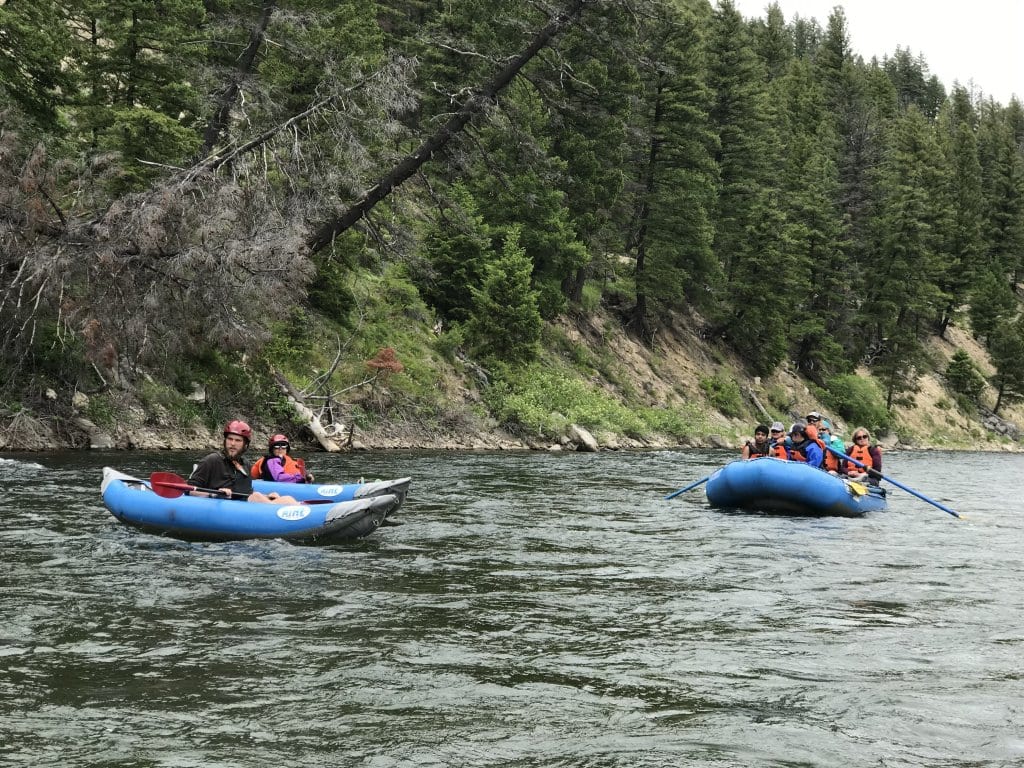
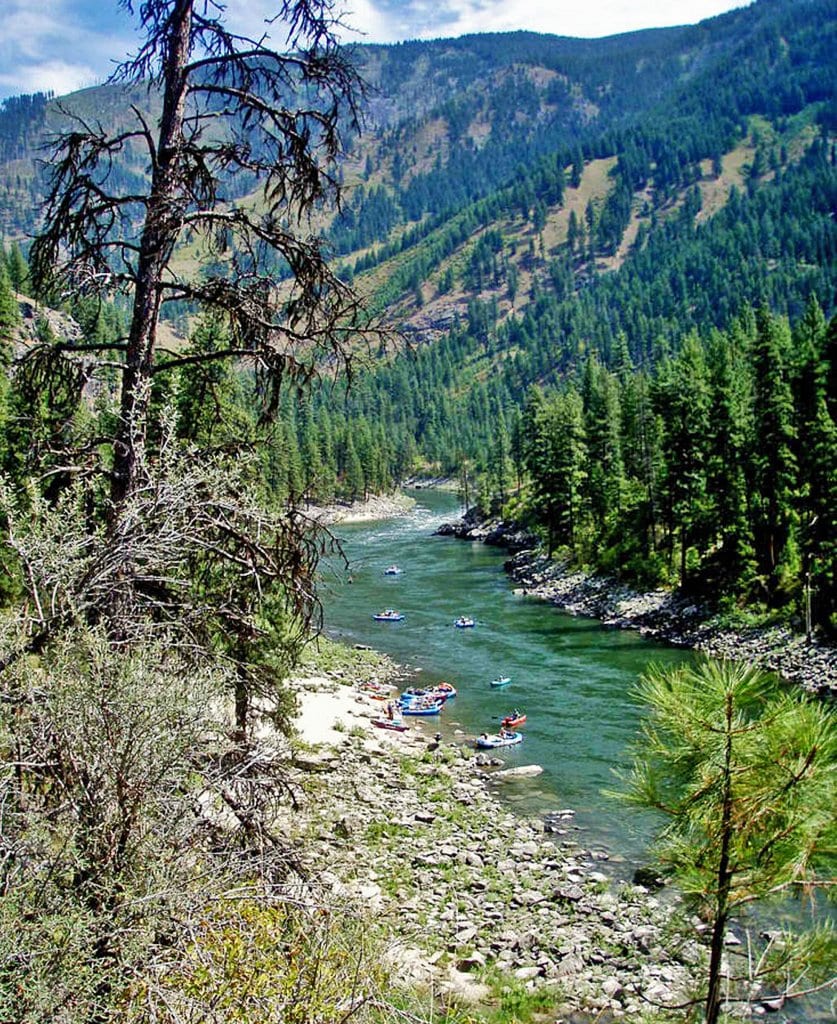
What to Expect on Your First Rafting Trip
Your first rafting trip will be an unforgettable adventure! Here’s what typically happens:
- Arrival and Check-in: Arrive at the designated meeting point and check in with your outfitter.
- Gear Up: You’ll be outfitted with a PFD, helmet, and paddle. If the weather is chilly or the water is cold, you might also receive a wetsuit or splash jacket.
- Safety Briefing: Your guide will provide a comprehensive safety talk, explaining the risks, procedures, and how to use the equipment.
- On the Water: Typically, your guide will start by teaching you basic paddling techniques on calmer water before heading into more challenging rapids.
- Wrap Up: After the trip, you’ll help gather gear and head back to base, where many times you can view photos, shop for souvenirs, and relive your exciting experience. Don’t forget to tip your guide – gratuity is greatly appreciated if you had a great experience!
Top Whitewater Rafting Safety Questions + Tips and Guidelines
Many beginners to whitewater rafting often wonder, is whitewater rafting dangerous? Like any adventure sport, there are inherent risks due to the dynamic nature of river environments. However, with the right preparation, guidance and safety measures, whitewater rafting can be a safe and exciting adventure. Outfitters take your safety seriously and have the equipment, experience, and training to mitigate that risk.
- Rapids: rivers are graded on a scale from Class I to Class VI (see chart above). The risk increases with the class of rapids, with higher classes requiring more skill and expertise.
- Guide Expertise: Professional guides who are trained and experienced in river navigation and emergency response play an important role in managing the risks associated with whitewater rafting. Guides help to mitigate risks and make strategic decisions about which sections of the river are appropriate to navigate based on conditions and the group’s skill level.
- Safety Gear: Wearing the right safety gear, including helmets, PFDs, and sometimes wet or drysuits, significantly reduces the risk of injury.
- Environmental Conditions: Weather and water conditions such as water level, flow rate, and temperature can affect the difficulty of a rafting trip. Sudden weather changes can create hazardous conditions, so it’s important to be prepared and heed local advisories.
- Preparedness and Physical Condition: Some rafting trips require little-to-no physical conditioning, while others require a reasonable level of fitness. Depending on the river, participants should be prepared to paddle and manage bumps and jolts from hitting rocks or navigating rapids.
- Pre-Requisites & Age Limits: Outfitters set minimum ages for your safety; even though your child might be an athletic, strong swimmer, outfitters typically cannot make exceptions to the minimum age – both for your safety and for insurance purposes. Similarly, many advanced rivers require a minimum experience level, such as “previous Class IV rafting experience.” It’s important to respect these prerequisites for your safety and that of the group.
- Training and Briefings: Pre-trip safety briefings are essential to educate participants on how to handle the raft, use safety equipment, and respond to falling out of the boat.
The most common question we hear from first-time rafters is “What happens if I fall out of the raft?” Falling out of the raft is a possibility in whitewater rafting, but outfitters prepare you with guidelines to be able to handle it confidently. Here’s what to do if you take an unexpected swim:
- Stay Calm – It’s natural to feel a rush of adrenaline, but staying calm helps you react effectively. Take a moment to orient yourself and look for your guide for instruction.
- Float on Your Back – Assume the “whitewater swim position” by floating on your back with your feet downstream. This helps you avoid hitting obstacles and keeps your head above water.
- Look for the Raft – Your guide and fellow rafters will work quickly to get you back in the boat. Try to reach for the raft or listen for instructions.
- Swim to Safety – If you’re close to the raft, swim toward it so your crew can pull you in. If the current is taking you away, swim toward the nearest calm water, into an eddy or to shore. Your guide will be pointing in direction that you should swim. The “whitewater swim position” mentioned above is the best way to ride out the rapid and get oriented, but once you locate your guide and receive verbal instructions, be an active participant in your own rescue. If you are being instructed to swim, get on your belly and swim aggressively. This will significantly expedite your rescue.
- Grab a Throw Rope – Though rare, guides may deploy a throw rope if you’re too far from the raft. Grab the rope (not the bag) with both hands, place it over your shoulder with your back to the guide, and let them pull you in. Never wrap it around your hands, arms, or body to prevent entanglement.
- Avoid Standing Up in Moving Water – If the water is still flowing, don’t try to stand up, as your foot could get trapped between rocks (a hazard known as foot entrapment). Wait until you reach calm, shallow water to stand up.
Guides train for these situations and will coach you through it if you fall out. With proper gear (life jackets and helmets) and guidance, a swim can be just another part of the adventure!
Overall, while whitewater rafting does have risks, the activity is generally considered safe when conducted under the guidance of professional outfitters who prioritize safety. Listening to your guide is crucial—they know the river and can help you navigate through the gnarly sections safely. Learn the hand signals for “stop,” “paddle forward,” or “get down,” as verbal commands can often be drowned out by the noise of the river. Stay alert, keep your hands on the paddle, and always have a watchful eye on the water and your fellow rafters. Many people enjoy rafting each year without incident, taking home only great memories and stories of adventure.
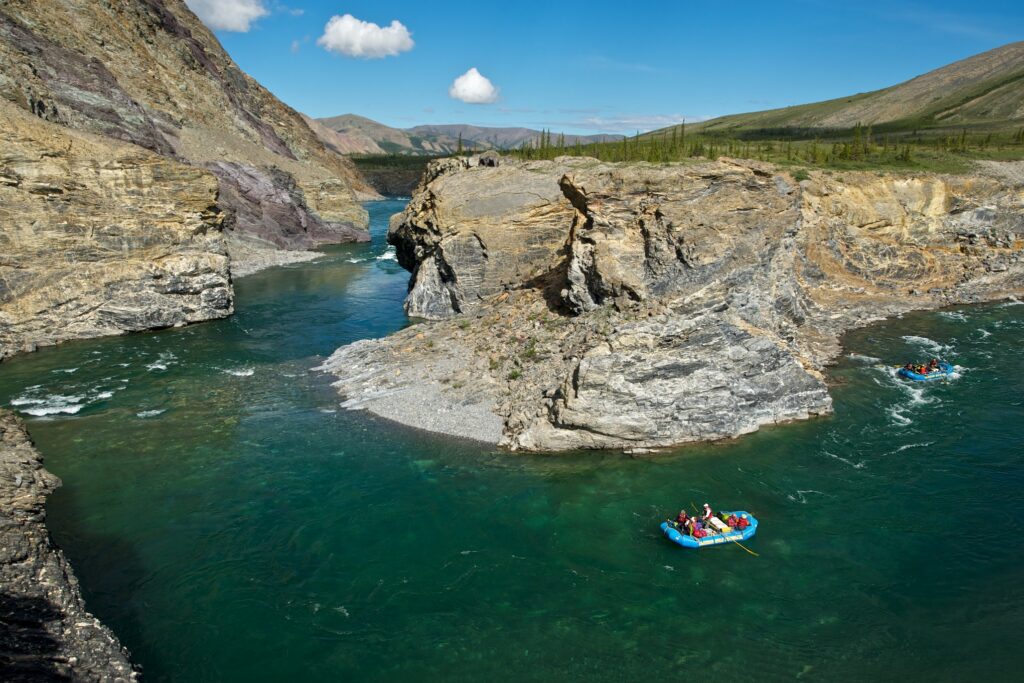
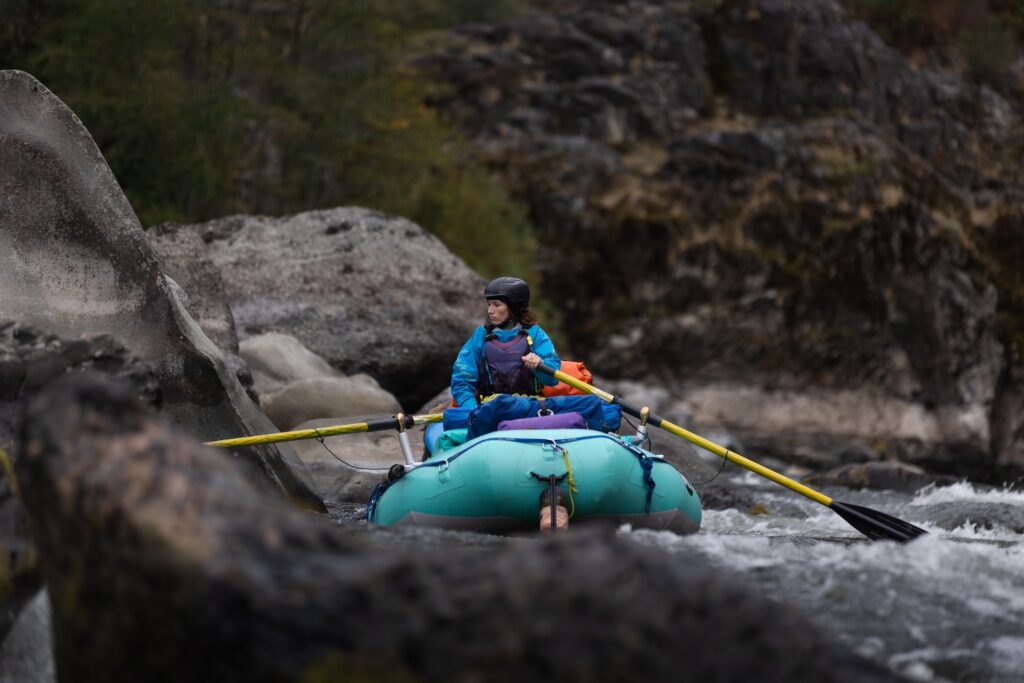
Understanding River Etiquette
Sharing the river responsibly ensures everyone has an epic time. Always avoid littering—pack out what you pack in. Wear retaining straps on hats and sunglasses to ensure they don’t become trash in the river. Be mindful of your noise level to preserve the tranquil nature setting and respect other river users. When encountering other boats, kayakers, or wildlife, maintain a safe distance and navigate crowded areas calmly and courteously. Understanding and practicing good river etiquette not only protects the environment but also enhances safety for everyone on the water.
Common Rafting Terms
- Eddy: A calm spot in the river where the current flows upstream, often behind a large rock.
- Hole: A spot where water flows back on itself after going over an obstruction, creating a recirculating current.
- Strainer: An obstacle like fallen trees or branches that water can pass through but solid items (like a boat or person) cannot.
- High-Siding: A command given when a raft is in danger of flipping; rafters must move to the high side of the raft to prevent it from capsizing. Think “high side, dry side.”
- Get Down: A safety command instructing rafters to crouch low in the raft, keeping their center of gravity low to stay stable in big rapids or when a flip is possible.
- T-Grip: The top of a paddle handle, which should always be controlled with one hand to prevent accidental hits or injuries.
- PFD (Personal Flotation Device): A life jacket designed to keep you afloat in the water. It must be properly fitted and securely fastened at all times while on the river.
Paddle Commands
Paddle commands are verbal cues given by a whitewater rafting guide to coordinate the crew’s movements and navigate the river effectively. Here are the most common ones you’ll hear on the water:
- All Forward: Everyone paddles forward in unison for speed or to maneuver through rapids.
- All Back: Everyone paddles backward to slow down, stop, or adjust the raft’s position.
- Left Forward / Right Forward: Only the left or right side paddles forward, helping to turn or angle the raft.
- Left Back / Right Back: Only the left or right side paddles backward, used for precise maneuvering.
- Hold On: A command signaling rafters to grab the raft’s safety lines or handles when approaching big waves, holes, or obstacles.
- Lean In: Used when navigating technical rapids or hitting obstacles to prevent falling out. Rafters lean into the raft rather than away from the impact.
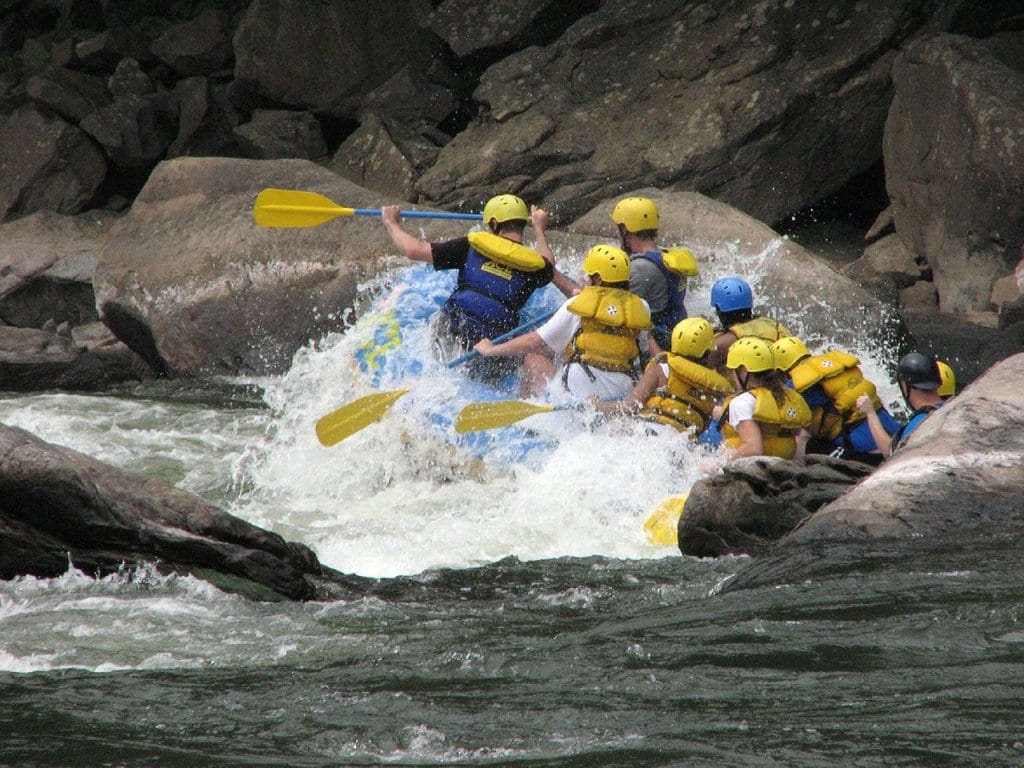
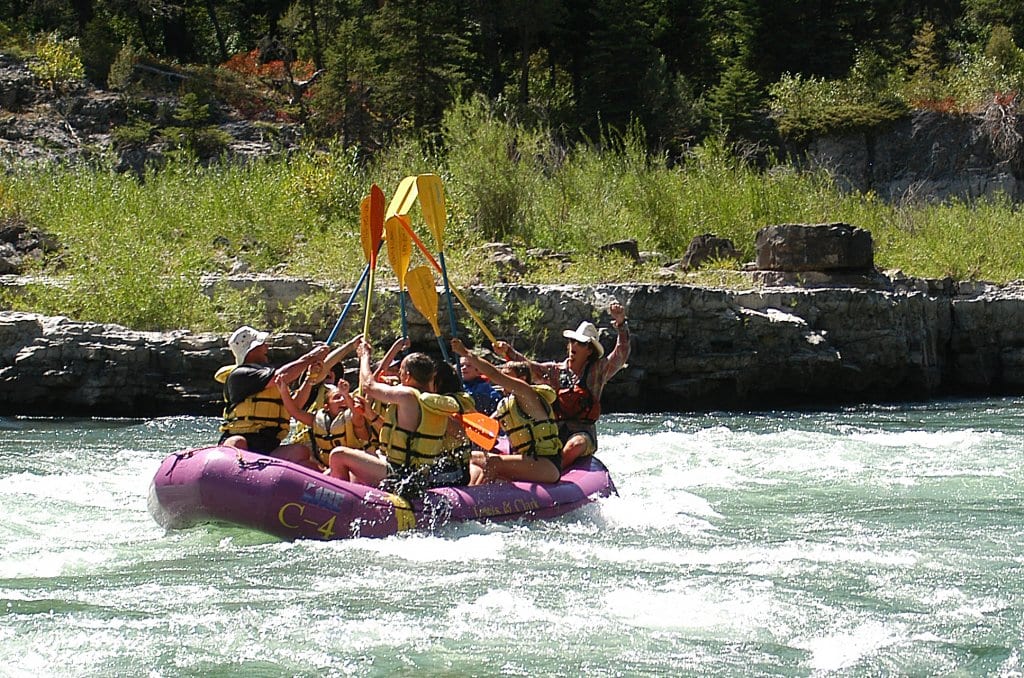
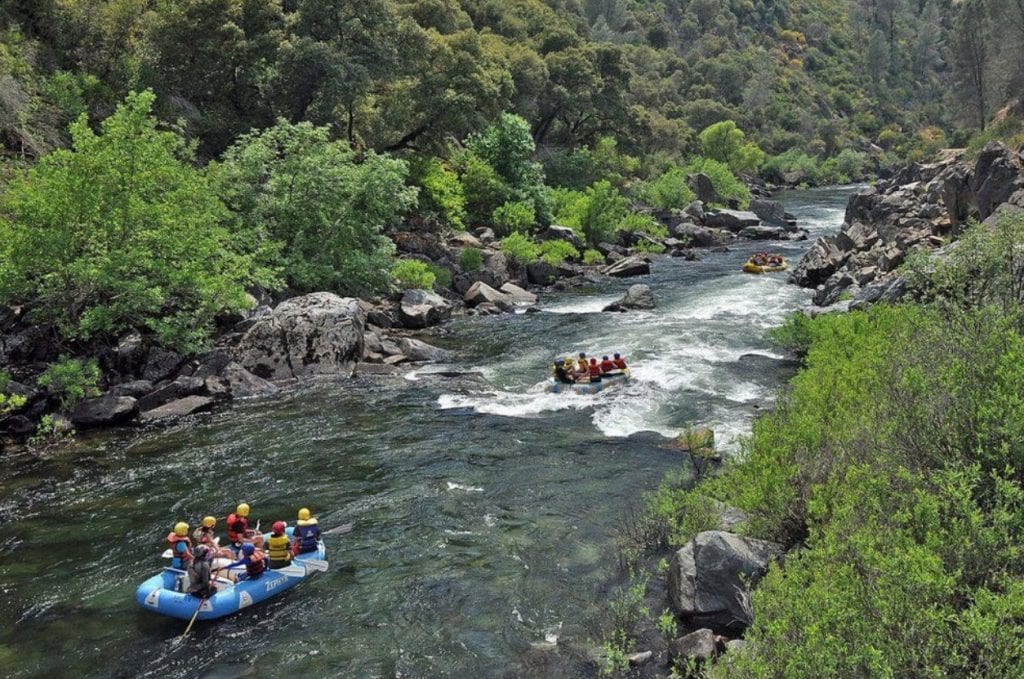
Top Rafting Destinations for Beginners
Here are some of the best whitewater rafting spots in the US for beginners:
| River Name | Location | Class | Description |
| Nantahala River | North Carolina | II-III | With calm, wide sections interspersed with manageable class II-III rapids, this river provides an ideal introduction to whitewater rafting. |
| Arkansas River | Colorado | II-III | One of the most popular rafting destinations in the U.S, the Arkansas offers options for all ability levels. Browns Canyon & Bighorn Sheep Canyon are a perfect starting point. |
| Snake River | Jackson, Wyoming | II-III | Offers the option for either scenic class I-II floats with mild rapids, great for families, or the infamous Alpine Canyon whitewater rafting trip, perfect for adventurous beginners. |
| Green River | Jensen, Utah | II-III | Features gentle stretches perfect for new rafters – it’s a great location for beginners looking to build confidence on the water while still experiencing the excitement of whitewater rafting. |
| Rio Grande | Taos, New Mexico | II-IV | The Class II-III sections of the Rio Grande are perfect for those new to rafting, with manageable rapids that still offer plenty of excitement. You’ll float through the stunning desert canyon landscape, with towering cliffs, deep gorges, and the possibility of spotting wildlife like bighorn sheep, eagles, and otters. |
| French Broad River | Ashville, North Carolina | II-III | The river runs through the Appalachian foothills, with stretches of Class II-III rapids that provide just the right amount of thrill for beginners. You’ll paddle past scenic overlooks, rural farmland, and dense forests – a beautiful and peaceful setting for new rafters |
| Colorado River | Moab, Utah | I-III | Features iconic scenery that desert rafting is famous for, and a range of rapids levels, making it perfect for a wide range of adventure levels. |
| American River | Coloma, California | II-III | The American River is famous for its Class II-III rapids that offer a perfect introduction to whitewater rafting. |
| Deschutes River | Maupin, OR Bend, OR | II-III | Perfect for those seeking an action-packed adventure combined with breathtaking Oregon landscapes |
Heading to Colorado? Check out the Best Places for White Water Rafting in Colorado.
What to Wear Whitewater Rafting
Not sure what to wear on your white water rafting trip? No sweat! Most people wear a swimsuit underneath quick-dry shorts, a t-shirt or tank top, and river sandals or water shoes. Wearing flip-flops is a no-no because they can easily come off and get lost in the river. Neoprene booties with rugged soles are preferred (and can usually be rented) in colder waters.
Some rivers will require wetsuits, while a t-shirt and shorts are suitable for others. Recommended attire varies from river to river, so be sure to review the requirements for the river trip you’re considering. However, you should always avoid cotton, as cotton is a negative insulator, which means it keeps you cold when wet and doesn’t dry quickly. Opt for synthetic fabrics and natural fibers, like wool or fleece.
What to Wear Rafting in Cooler Weather
- Wetsuit
- Splash jacket
- Extra wool or fleece insulating later
- Wool socks
- Neoprene booties
Shoulder season trips & colder rivers typically offer or require wetsuits. Outfitter wetsuits are usually “farmer john” style, with long pants on the bottom and sleeveless straps on the top. If wearing a wetsuit, bring a swimsuit or swim shorts to wear underneath. If you run cold, feel free to wear a wool or fleece long-sleeve underneath the wetsuit for extra insulation on cold days. You can pair wool socks with your river booties to keep your toes warmer.
What to Wear for Warm Weather Rafting
- Quick dry top and shorts (no cotton!)
- Sturdy sandals (with straps) or neoprene booties
- Hat for sun protection
- Sunglasses with strap
If you’re rafting in peak season on a warmer river, wetsuits are typically not necessary. For these rivers, you’ll want to wear synthetic, wool, or other natural fibers that wick moisture. For example, swim shorts and a sun shirt are perfect for these conditions. If footwear is not provided, sandals with a retaining strap or water shoes are recommended.
Packing the appropriate clothes and gear for your rafting trip is essential as it will make things more convenient for you. It is always great to bring a bag along in your car for wet clothes after the trip, as well as an extra set of dry clothing.
It is usually not recommended to bring gadgets like phones and cameras on your white water rafting trip. The rule of thumb is that you should avoid bringing anything you don’t want to lose. There is a high probability that these could get lost or dropped in the river. Waterproof cases can reduce the risk of damage to these items. Many rafting outfitters offer professional pictures of your trip!
Rafting Packing List
- ID
- Sunscreen
- Sunglasses with retainer strap
- Hat
- Towel
- Lip balm
- Food/snacks
- Water bottle
- Swimsuit
- Dry bag
Rafting Pre-Trip Preparation
It’s important to find the best guides for your white water rafting adventure. We’ve vetted and curated the best rafting guides to make your planning process simple! Connect and book directly with the guide once you’ve compared and chosen the perfect adventure.
Before you hit the rapids, a little prep can go a long way. Strengthen your upper body, core, and legs with exercises like push-ups, planks, and squats to improve your paddling power. Hydration is key, so drink plenty of water the day before and the morning of your trip. A good night’s sleep before your adventure ensures you’re rested and ready for the physical challenge ahead.
River Conservation Spotlight: American Whitewater
At TripOutside, we believe that outdoor adventure and conservation go hand in hand—which is why we’re proud to feature American Whitewater, a leading nonprofit dedicated to protecting and restoring the rivers we love to paddle. Their mission to keep rivers clean, wild, and accessible directly aligns with our mission: to get more people outside on meaningful, human-powered adventures with fewer barriers and less impact on ecosystems.
Who They Are & Where They Work
American Whitewater is a national nonprofit organization founded in 1954 by river enthusiasts, paddlers, and conservationists. With members and local affiliates across the country, they are the only national organization solely focused on preserving and enhancing whitewater rivers. Their goals are:
- Protect and restore free-flowing rivers
- Secure public access to rivers and river corridors
- Advocate for responsible, low-impact whitewater recreation
- Promote dam removal and river flow restoration projects
- Monitor and influence hydropower relicensing and water policy
Their work ensures that rivers remain wild, clean, and open to the public—so paddlers of all skill levels can continue to enjoy them for generations to come.
American Whitewater operates throughout the United States, with a strong presence in mountain regions and river corridors including the Rockies, Appalachians, Pacific Northwest, and Sierra Nevada. They work on iconic rivers like the Chattooga, Gauley, Tuolumne, Colorado, and Dolores, among many others.
How You Can Support
- Donate to support river advocacy and conservation projects: americanwhitewater.org/donate
- Become a member to stay up to date and help shape the future of river recreation
- Get involved locally with river cleanups, public meetings, and paddling groups
- Spread the word – share this post and let others know about the work they do
By choosing human-powered river adventures and supporting organizations like American Whitewater, you’re playing a vital role in protecting the rivers that make these experiences possible.
Beginner White Water Rafting Summary
Kicking off your whitewater rafting journey combines the beauty of nature, adrenaline, and camaraderie. Rafting allows you to connect with the wild, discover remote, pristine environments that few get to see, and push your limits safely. As you prepare for your first rafting adventure, remember the importance of choosing the right trip for your skill level, learning the do’s and don’ts of river etiquette, and gearing up appropriately. Safety is paramount, so always follow your guide’s instructions, and stay alert. Most importantly – enjoy every moment! Let the river be your guide to a world of adventure!

